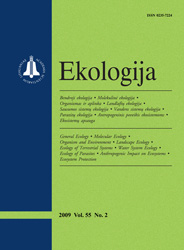 ISSN 0235-7224 ISSN 2029-0586 (online) |
2010 m. Nr. 3-4 Mapping total nitrogen in ash after a wildland fire: a microplot analysis.
Nitrogen (N), due its low temperature volatilization, is one of the elements most vulnerable to fire. This effect depends on fire severity, which varies depending on biophysical conditions which can be heterogeneous across the landscape. Hence, fire effects on N can be variable. The aim of this study was to establish the ash total nitrogen (TN) spatial variability in a microplot designed in a burned area, and to test several methods in order to identify the most accurate one for interpolating the variable. In total, we selected four deterministic interpolation methods – inverse distance to a weight (IDW), with the weight of 1, 2, 3, 4 and 5, local polynomial (LP), with the power of 1 and 2, global polynomial (GP), radial basis functions (RBF) – spline with tension (SPT), completely regularized spline (CRS), multiquadratic (MTQ), inverse multiquadratic (IMTQ) and thin plate spline (TPS) – and two geostatistical methods: ordinary kriging (OK) and simple kriging (SK). In total, we tested 15 techniques. Ash TN was negatively related to fire severity showed a good spatial structure across the plot. The linear model was the best, which means that the variability of ash TN content increased in all the area of interest. The highest concentration of TN was observed in the northeast part of the plot and the lowest in the Southwest. From all test methods, MTQ was most accurate, and IDW5 was the worst predictor. In general, RBF and the geostatistical methods were most precise and IDW was less accurate, which means that ash TN distribution has some specific features and does not exhibit a small-scale variation. The distribution of the variable depends on species distribution, temperature and probably on vegetation moisture during fire evolution. Keywords: fire severity, biophysical conditions, ash total nitrogen, microplot, interpolation methods |
Issues:
2011 - Vol.57 No. 1, No. 2 2010 - Vol.56 No. 1-2, No. 3-4 2009 - Vol.55 No. 1, No. 2, No. 3-4 2008 - Vol.54 No. 1, No. 2, No. 3, No. 4 2007 - Vol.53 No. 1, No. 2, No. 2.priedas, No. 3, No. 4 2006 No. 1, No. 2, No. 3, No. 4 2005 No. 1, No. 2, No. 3, No. 4 2004 No. 1, No. 2, No. 3, No. 4 2003 No. 1, No. 2, No. 3, No. 4 2002 No. 1, No. 2, No. 3, No. 4 2001 No. 1, No. 2, No. 3, No. 4 |